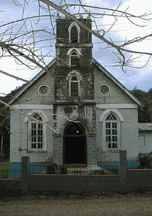STORY:
Waldensians derive their name from that of an early Christian community known as the "Waldenses".
The Waldenses are named after a 12th century merchant, Peter WALDO, who lived in Lyons, France, and who, around 1175, gave up all his possessions to preach "Poverty for the sake of Christ". This view was not popular with the Catholic Church and he was excommunicated in 1184.
A Society developed out of his followers, and promoted discipline while being critical of unworthy clergy and abuses of the Church. In 1208 a Crusade was authorised against the Waldenses and eighty of them were burned at the stake in 1211. The majority withdrew into Alpine valleys in Italy and lived a marginal existence until they joined with Protestant reformers in 1552. They were given "freedom of the valley" in 1561 (this was the valley of Piedmont in Italy), though they suffered intermittent persecution over the next three centuries due to the Catholic/Protestant war; there was a massacre of Waldensians in the seventeenth century and this may have led to emigration to Jamaica of some Waldensians.
In 1848, Waldensians obtained full civil rights and are now significant in Italian theological dialogue. They are members of the World Presbytarian Alliance and have small congregations in North and South America.
MARKET APPEAL:
Waldensians constitute a small part of our cultural heritage and will probably be of interest to historians and to current followers of this Protestant sect. And to the many persons named Waldo.
RESOURCES:
Waldensia All Age School in Sherwood Content and nearby Waldensia Baptist Church are reminders of this sect. The Piedmont district of Sherwood Content was owned and named by William Flash, who was a Waldensian, and part (“Church Bottom”) was given to William Knibb for the construction of a chapel which he called "Waldensia". The chapel was rebuilt on the present site in nearby Content in 1875. The Content Great House became the Baptist Manse.



